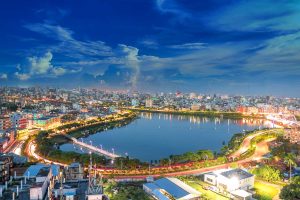
Dhaka City: The Heart of Bangladesh
Introduction to the Dhaka City
Dhaka city, the bustling capital of Bangladesh, is one of the most densely populated urban centers in the world. Often called the heartbeat of the nation, Dhaka city plays a central role in politics, culture, education, and business. With over 20 million residents, Dhaka city is not only the largest city in Bangladesh but also among the fastest-growing megacities globally. Its energy, diversity, and constant movement create both opportunities and daily challenges, making Dhaka city a vibrant and dynamic hub
Historical Background of Dhaka City
The city’s history stretches back centuries, with notable growth during the Mughal Empire. In the early 17th century, it became the capital of Bengal, emerging as a center for trade and administration. The region gained fame for its muslin fabric, which was highly valued across Europe and Asia.
Old neighborhoods still showcase this heritage through narrow streets, Mughal-era mosques, and landmarks such as Lalbagh Fort and Ahsan Manzil. Colonial-era buildings also dot the landscape, narrating the story of British rule and local resistance. This mix of Mughal, colonial, and modern structures gives the city its unique character.
Urban Growth and Modernization
Over recent decades, the city has transformed significantly. Rapid urbanization, industrial expansion, and migration from rural areas have shaped it into a sprawling metropolis. Modern buildings, shopping complexes, and flyovers define much of the skyline, while projects like the metro rail aim to improve transportation.
Growth, however, comes with challenges. Traffic congestion, inadequate infrastructure, pollution, and waste management issues impact daily life. Despite these difficulties, people from across Bangladesh continue to move here for better employment, education, and healthcare opportunities.
Cultural Life
Culturally, the city is the heart of Bangladesh. Known as the “City of Mosques,” it also hosts Hindu temples, churches, and Buddhist monasteries, reflecting religious diversity.
Major cultural events, including the Ekushey Book Fair, the International Film Festival, and Pohela Boishakh celebrations, highlight the nation’s traditions. Theatres, galleries, and music venues showcase both classical and contemporary arts. Street food is another defining feature, with biryani, fuchka, and other local delicacies offering a taste of shared heritage and community spirit.
Education Hub
As an academic center, the city houses leading universities, colleges, and schools. Institutions like the University of Dhaka, Bangladesh University of Engineering and Technology (BUET), and BRAC University attract students nationwide. International and English-medium schools also operate here, making it a prominent destination for education.
Libraries, research centers, and cultural organizations further strengthen its role as a hub of knowledge, fostering leadership, creativity, and innovation that benefit the entire nation.
Economic Significance of Dhaka City
The capital is the economic powerhouse of Bangladesh. The garment industry, one of the largest worldwide, is centered here, employing millions. Export processing zones and commercial districts support international trade. Beyond textiles, the economy thrives on IT services, banking, small businesses, and retail.
The city is also vital for transportation and logistics. With Hazrat Shahjalal International Airport and major road networks, it connects Bangladesh to global markets. While infrastructure challenges persist, the area remains a key driver of the nation’s economic growth.
Daily Life and Community
Life in the capital is energetic and fast-paced. Streets are filled with rickshaws, buses, and motorbikes, creating a rhythm unique to the city. Markets bustle with shoppers, and tea stalls serve as gathering points for conversation.
Residents contend with long commutes, high living costs, and limited green spaces. Yet, the community’s resilience and hospitality shine through, keeping the city alive during both ordinary days and festive celebrations.
Attractions and Leisure Spots
Visitors have a wide range of sites to explore. Lalbagh Fort, Ahsan Manzil, and the National Museum display the country’s heritage. The Liberation War Museum provides insights into Bangladesh’s independence struggle.
For relaxation, Hatirjheel and Ramna Park offer scenic retreats within the urban environment. Old city areas, with their traditional markets, foods, and historic architecture, remain must-visit destinations that capture the richness of both past and present.
Challenges and Development
Despite its vibrancy, the city faces pressing issues. Overpopulation strains housing and public services, traffic congestion reduces productivity, and pollution threatens health. Flooding during the monsoon season underscores the need for better planning.
Authorities, the private sector, and international organizations are tackling these problems through infrastructure improvements and sustainable development initiatives.
Resilience and Spirit
What sets the city apart is the determination of its residents. Entrepreneurs launching businesses, students pursuing higher education, and workers powering industries all contribute to its vitality.
The warmth and hospitality of the people ensure that, despite challenges, newcomers and visitors feel welcome. This resilient spirit drives the city forward, shaping the future of Bangladesh.